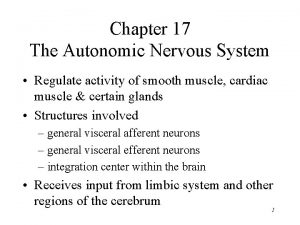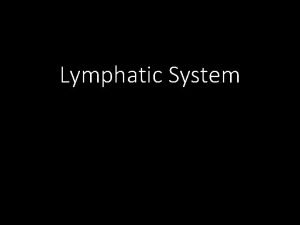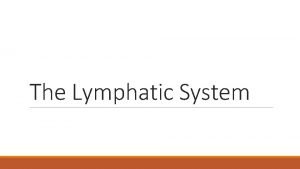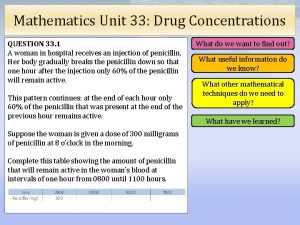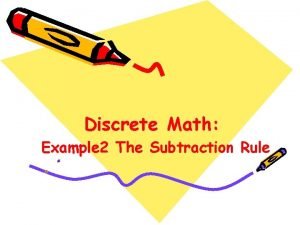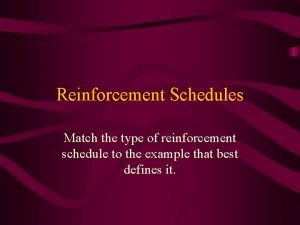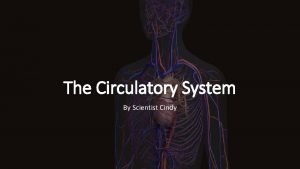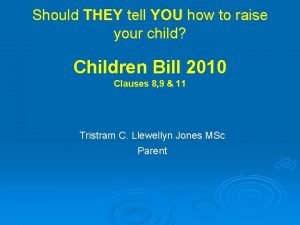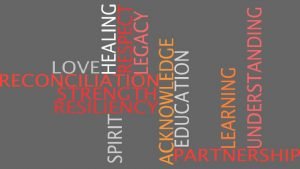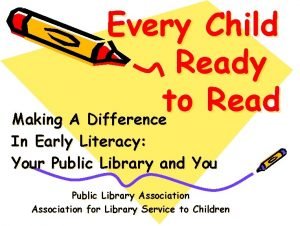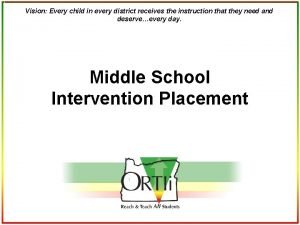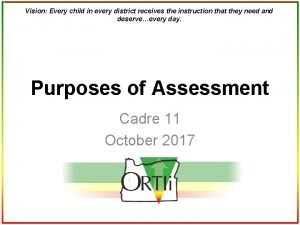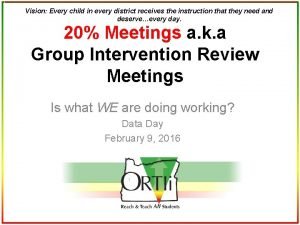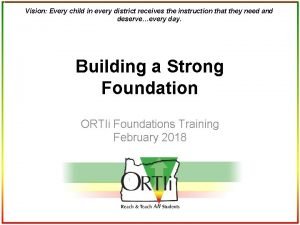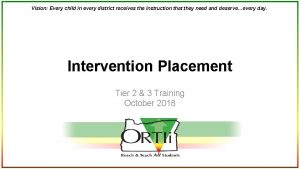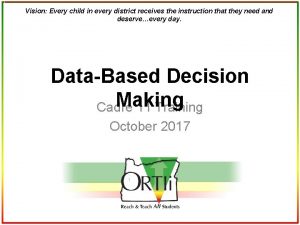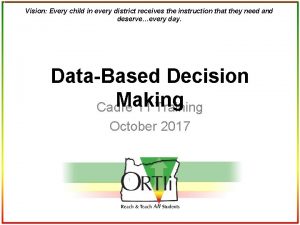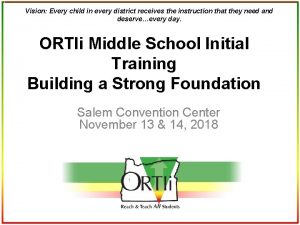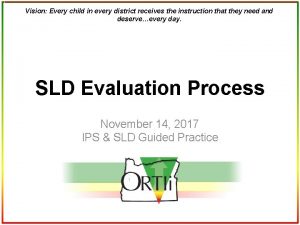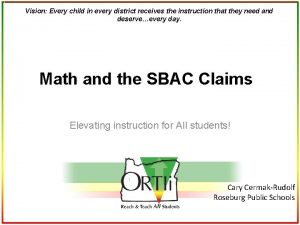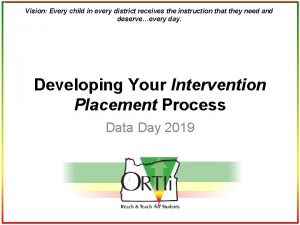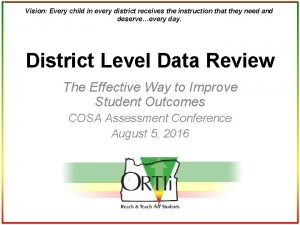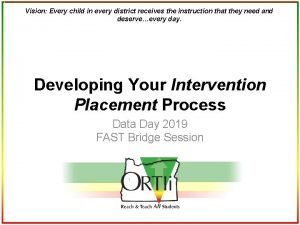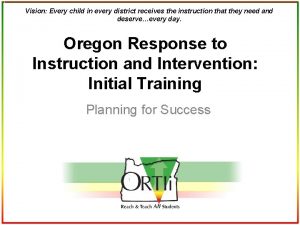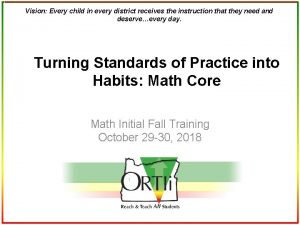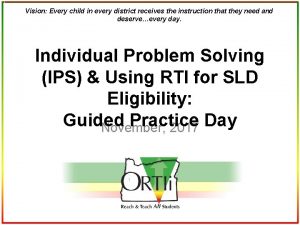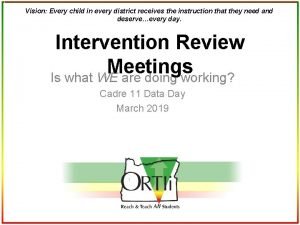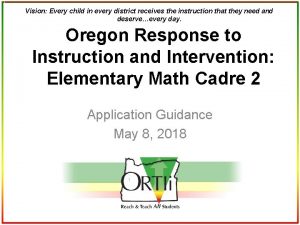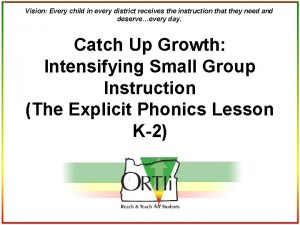Vision Every child in every district receives the


























































- Slides: 58

Vision: Every child in every district receives the instruction that they need and deserve…every day. Core Review Meetings Moving from Where We Are to Where We Want to Be (one grade level at a time)

Purpose: Core Review Meetings • Determine if the grade level is benefiting from core instruction AND • Refine core instruction to better meet the needs of ALL students at the grade level.

Why do we look at whole grade level data?

Why do we look at whole grade level data? 5% 25% 50% 10% vs 85% Is this a whole grade level need or a some students need?

Change is Messy

Target Understand how to use the problem solving steps for Core Review Meetings

How: Installation Matrix

Installation Matrix

What we hear…. • • • Our kids are different They have more issues My class is fine…. It’s the other teachers Our core doesn’t work My kids need help…. From someone else

Just Do It!

Just Do It! • Professional Learning impacts Skills • Skills impact Practice • Improved Practice s e c i Pract improves Implementation f • Improved Implementation e i l Be impacts student outcomes on i t s enta • Better student outcomes m e l p Im shift Beliefs

Installation Matrix

General Features When: 3 times per year (following collection of your schoolwide screening data) Who: Principal Grade level team Literacy Specialist/Title I Counselor Could include SPED, ELL, School Psychologist, Paraprofessionals

General Features What: Use schoolwide screening data to answer questions about core instruction Outcomes: Identify which of the 5 Big Ideas need additional focus AND develop a plan (with a goal) for improving grade level achievement

Core Review Meetings PLCs Purpose Improve the instruction for the grade level To ensure students have learned the content taught Who is discussed ? • Grade level or grade bands (no students names) • Grade level classes (students) Who attends Grade level team Principal Grade level team and others Literacy Specialist/Title I/Literacy Guru as invited Others as determined by Building Leadership Team Frequency • 2 to 3 times a year (following Universal • Weekly/bi-weekly Screening) Data DIBELS/AIMSweb/easy. CBM grade level reports (Risk Analysis) SBAC Common Formative Assessments Professional development Grade level agreements around Differentiated instruction within the classroom based Outcomes

Installation Matrix

Core Review Meeting Process

Step 1: Problem Identification 1. Problem Identification Improved Student Achievement 18 What is the problem?

1. Problem Identification Where we want to be At least 80% at benchmark on screening data Grade Level Where we are Determine percentage of students at benchmark from screening data

Is the grade level where we want them to be? 5% 15% 25% Is it a whole grade level need or a some kids need? At least 60% Where we are 80% Where we want to be

Core Review Meetings Grade 1. Problem ID 2. Problem Analysis 3. Plan 4. Evaluate Screening Data Low (Whole grade level need)

Problem Identification How well are you using your screening data to look at the effectiveness of your core?

The Problem Solving Process 1. Problem Identification Improved Student Achievement 2. Problem Analysis Why is the problem occurring? 23

2. Problem Analysis Why is the problem happening? * What is the grade level’s priority skill need(s)? – Comprehension – Vocabulary – Fluency – Phonics – Phonemic Awareness

Why is the problem happening? Foundational Skills Phonics (Alphabetic Principle) Phonemic Awareness Vocabulary Reading Comprehension Oral Reading Accuracy & Fluency

What is the priority skill need? 5 Big Ideas Percentage of Students at Benchmark Comprehension 57% Vocabulary 75% Fluency 65% Phonics 60% Phonemic Awareness 85% We want the priority skill to be close to 80% (at least)

Core Review Meetings Grade 1. Problem ID 2. Problem Analysis 3. Plan 4. Evaluate Screening Data Low (Whole grade level need) Phonics need

Problem Analysis What problems can develop if the grade level does not focus on the appropriate skill need? E. g. , comprehension when they need phonics

Step 3: Plan Development 1. Problem Identification Improved Student Achievement What are we going to do about the problem? 29 3. Plan Development 2. Problem Analysis

3. Plan Identification *How should we address the priority skill need(s)? • Make common agreements

3. Plan Identification: *Make common agreements around: Curriculum Instruction Environment (We can control these things) And provide professional learning opportunities to allow staff to implement these agreements

Student Learning Instruction: How you teach Environment: Where you teach 32 Curriculum: What you teach Learner: Who you teach

Student Learning Curriculum: What you teach Foundational Skills Oral Reading Phonics (Alphabetic Principle) Phonemic Awareness Vocabulary Reading Comprehension 33 Accuracy & Fluency What you teach

Common Curriculum Needs • How much does your curriculum address the priority skill need? • Do you need to spend more time focused on the priority skill(s).

Student Learning Instruction: I DO WE DO YOU ALL DO How YOU DO How you teach What do we need to enhance in our instruction of the skill need? 35

Importance of Active Engagement How many times it takes to learn something new? 4 -14 times • Above Average Learner 14 -250 times • Average 250 -350 times • Truly disabled student Jo Robinson (2008)

Common Active Engagement Strategies How we keep students involved • Oral Responses • Written Responses • Action Responses How should we increase our active engagement of the priority skill need?

Student Learning Environment: Where you teach Behavioral Strategies Classroom Set Up Reinforcement Where. Systems you teach Routines What do we need to enhance? 38

Core Review Meetings Grade 1. Problem ID 2. Problem Analysis Screening Data Low (Whole grade level need) Phonics need Spend more time teaching 3. Plan phonics & increase I do and we do instruction 4. Evaluate

Talk Time Why is having common agreements for curriculum, instruction, and environment helpful?

3. Plan Identification: *Make common agreements around: Curriculum Instruction Environment (We can control these things) And provide professional learning opportunities to allow staff to implement these agreements

Do teachers have the skills to implement the changes? • Model lessons by coach or peer • Peer lesson observation • Visit high performing schools within the district or area • In-school experts training at staff meetings • Instructional highlights at staff meetings • Don’t forget Paraprofessionals!

Ensure…. . Staff know how to make the changes that they have agreed to. Administrators know what to look for.

Fidelity to the Core • You have to inspect what you expect – Principal walkthroughs – Core program fidelity checks – Are we all doing what we agreed to do?

Step 4: Plan Implementation & Evaluation How is it working? 4. Plan Implementation & Evaluation 1. Problem Identification Improved Student Achievement 3. Plan Development 45 2. Problem Analysis

4. Plan Evaluation Did we improve?

4. Plan Evaluation 12% 15% 25% 18% 60% 70% Where we were Where we are now

Core Review Meetings Grade 1. Problem ID 2. Problem Analysis 3. Plan Screening Data Low (Whole grade level need) Phonics need Spend more time teaching phonics & increase we do and you do instruction Screening data have increased 4. Evaluate (still grade level need)

Installation Matrix

Disaggregated Data Template

Improving Your Core Common Environmental Strategies Common Curriculum Supports Monitor Common Instructional Strategies

Installation Matrix Data Day: January 25 th, 2018

This can get emotional!

What to Expect… Considering data that is close to home often triggers a sort of “grief-cycle” which can impede a team’s ability to effectively solve the problem(s) at hand • Denial (The data can’t be true/right!) • Anger (How dare they/you suggest we had anything to do with this!) • Bargaining (Maybe if we could just get the data to go away, everything could go back to normal. ) • Sadness (How could this have happened? ) • Acceptance (Ok, if these are the facts, let do something about it. ) Anticipate and recognize these emotional reactions as part of the process, but do not allow them to slow down or stop the process from moving forward

Look at your data….

Core Review Meetings What response(s) do you anticipate from your staff? and How might you respond? (Will it be hard to talk about the whole grade level rather than individual students. )

Change is Messy • Outcomes don’t change unless teaching and learning changes. * We may need to teach the core “on steroids” • Core Review Meetings support improved instruction!

Even with experience… there’s room for improvement
 Every child every day
Every child every day Human vision vs computer vision
Human vision vs computer vision Child vision foundation
Child vision foundation Left child right sibling tree
Left child right sibling tree The left side of the heart receives blood from the
The left side of the heart receives blood from the Mark receives a score report detailing his performance
Mark receives a score report detailing his performance What is the irony in how mercutio receives his wound?
What is the irony in how mercutio receives his wound? Miss cuba receives an invitation
Miss cuba receives an invitation Which target organ receives dual innervation
Which target organ receives dual innervation Mr brown receives a salary than anyone else in the company
Mr brown receives a salary than anyone else in the company When earth receives energy from the sun, ____.
When earth receives energy from the sun, ____. Surfaces of heart
Surfaces of heart The purified lymph with lymphocytes and antibodies added
The purified lymph with lymphocytes and antibodies added What receives the most solar radiation
What receives the most solar radiation The lymphatic system consists of
The lymphatic system consists of A woman in hospital receives an injection of penicillin
A woman in hospital receives an injection of penicillin Discrete math tutor
Discrete math tutor Schedules of reinforcement examples with answers
Schedules of reinforcement examples with answers Tribeculated
Tribeculated A wise man receives correction
A wise man receives correction Why was every child matters scrapped
Why was every child matters scrapped Every child matters be healthy
Every child matters be healthy Orange shirt day quotes
Orange shirt day quotes Every child is gifted they just unwrap
Every child is gifted they just unwrap Nparks every child a seed
Nparks every child a seed Pta every child one voice
Pta every child one voice Every child ready to read six skills
Every child ready to read six skills Every child a seed
Every child a seed Every mother loves her child tag question
Every mother loves her child tag question Every rotarian every year
Every rotarian every year Every nation and every country has its
Every nation and every country has its Every nation and every country
Every nation and every country Microsoft empower every person
Microsoft empower every person Every picture has a story and every story has a moment
Every picture has a story and every story has a moment Every knee shall bow every tongue confess
Every knee shall bow every tongue confess Phản ứng thế ankan
Phản ứng thế ankan Voi kéo gỗ như thế nào
Voi kéo gỗ như thế nào Thiếu nhi thế giới liên hoan
Thiếu nhi thế giới liên hoan điện thế nghỉ
điện thế nghỉ Một số thể thơ truyền thống
Một số thể thơ truyền thống Trời xanh đây là của chúng ta thể thơ
Trời xanh đây là của chúng ta thể thơ Thế nào là hệ số cao nhất
Thế nào là hệ số cao nhất Ng-html
Ng-html Hệ hô hấp
Hệ hô hấp Các số nguyên tố
Các số nguyên tố đặc điểm cơ thể của người tối cổ
đặc điểm cơ thể của người tối cổ Tia chieu sa te
Tia chieu sa te Các châu lục và đại dương trên thế giới
Các châu lục và đại dương trên thế giới Tư thế worm breton
Tư thế worm breton ưu thế lai là gì
ưu thế lai là gì Tư thế ngồi viết
Tư thế ngồi viết Cái miệng xinh xinh thế chỉ nói điều hay thôi
Cái miệng xinh xinh thế chỉ nói điều hay thôi Mật thư anh em như thể tay chân
Mật thư anh em như thể tay chân Các châu lục và đại dương trên thế giới
Các châu lục và đại dương trên thế giới Bổ thể
Bổ thể Tư thế ngồi viết
Tư thế ngồi viết Thẻ vin
Thẻ vin Thế nào là giọng cùng tên?
Thế nào là giọng cùng tên? Thơ thất ngôn tứ tuyệt đường luật
Thơ thất ngôn tứ tuyệt đường luật








